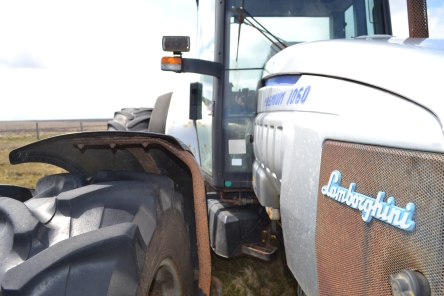First questions for many of you will be what are Lìn-bheaga? I think the English for them are Small/Short-lines. Basically a long-ish line with baited hooks on it. There are also Lìn-mhora – Long-lines – that are used, in my experience, for commercial fishing. I’ve had experience of fishing with Long-lines in the 90s, on my fathers fishing boat. Would use the Long-lines to catch Bioraich (Dog-fish). I was always told these would be used in shark-fin soup but I’m not sure if that was the truth or not. We would also catch Dalagan (Spotted Dog-fish).
Co-dhiu, these Lìn-bheaga were an experiment my father had been wanting to try for a long time. He is originally from the island of Scalpay, off Harris, famous for their fishing, and used to use Lìn-bheaga quite often but had never tried it in Ness, in the 33 years he’s lived here.
We’d prepared and baited the lines (with mackerel) several weeks ago and kept it in the freezer until weather conditions were better.

There are about 15o hooks on the line. This box was home-made to launch the lines

This is us parked up at the bottom of my croft, above Traigh Chrois, about to set the line. The beach is about a mile from my house.

There is an anchor attached to each end of the line, which are set at low tide. The tide then comes in and covers the line & baited hooks. Here is my dad attaching one of the anchors to the line.

My dad surveying the beach. I must point out that I did most of the hard-labour but it’s not easy taking pictures at the same time!!

It took us about 90 minutes to set the line. By this time, I had been waist deep in the sea. Fully clothed. My wellies had to be emptied 3 times….

We finished setting the line at around 2.30pm, just in time to go home and watch the Scottish Cup Final. We returned just after 6pm, before the tide got too high. As you can see from this picture, there was quite a lot of seaweed on the beach, something which I have never seen here before. We had rough weather earlier in the week, so a lot of it has come loose and come ashore. This was to prove to be a problem, as we will see shortly!

Starting to haul the line in. All this is done by hand. You can see from the nearest breaking wave, that it is full of seaweed. This ended up catching onto the hooks, instead of the flat-fish we were hoping to catch. It also made for hard work hauling it in! The line was gathered into the basket at my father’s feet.

We took about an hour to haul the line back in, with difficulty at some points. I would love to show you a picture of the basket we had down for all the fish we caught – but we got ZERO!!!!

All the hooks are safely tucked away into the foam rim of the basket.

So time to head home and plan our next assault on the beachhead!


















































































